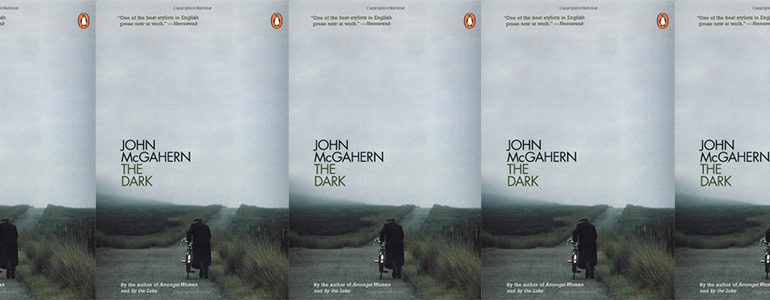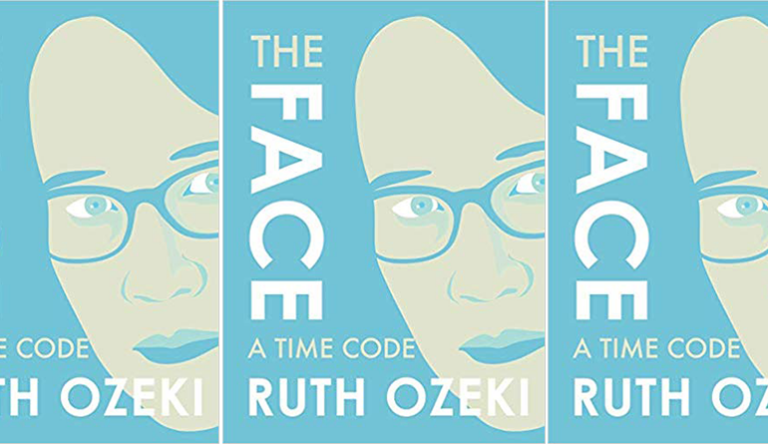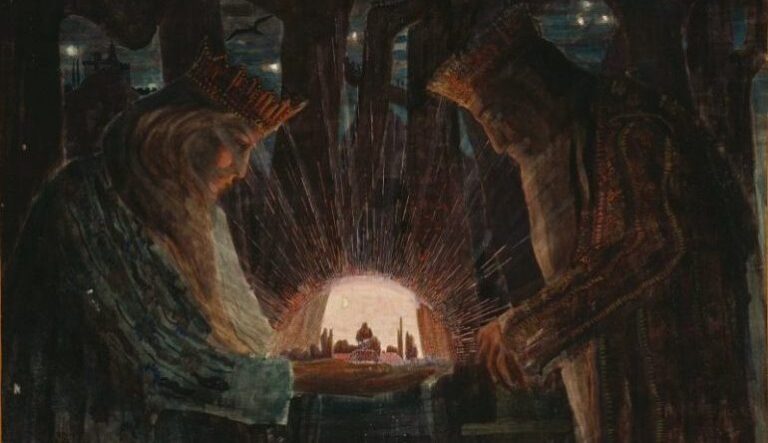Perspective in The Dark

In John McGahern’s 1965 novel, The Dark, the point of view of the protagonist shifts from first person to second person to third person and, perhaps most interestingly, to no point of view at all. In this slim, coming-of-age novel, we follow the unnamed narrator from childhood through young adulthood as he attempts to discern who he is and who he wants to be. As the point of view shifts throughout the novel, the narrator seems to be seeing himself through different lenses, just as he is redefining himself through his choices. (It may be relevant to note here that The Dark, McGahern’s second novel, was banned in Ireland—in part for its portrayal of the Church, and in part for its scenes of incest and masturbation. Because of this, McGahern lost his position as a schoolteacher and left Ireland for England, although he returned to Ireland later in life.) He moves in close with the first person, then pulls back with the third person, although the prominent voice in the novel is the second person: the narrator speaking to himself, an inverted first-person voice. The reader is swept along on this same fluid path, coming in close and then being pulled back, as unsure as the narrator as to where this journey will end.
The novel consists of thirty-one short chapters, organized chronologically, which essentially make up four parts, although they are not named: childhood (chapters 1–10); a visit with a priest (chapters 11–16); studying for certification exams (chapters 18–27); and university (chapters 28–31). The second-person voice appears in fifteen chapters, the third-person voice in eleven, and the first-person voice in three; two chapters have no discernable point-of-view. Within the first section, McGahern cycles through almost all of the points of view, teaching us how to read the novel, and a close look at this opening reveals how he uses point of view strategically to allow us to see the struggles of his protagonist.
The first chapter is in third person, and it begins with unattributed dialogue:
“Say what you said because I know.”
“I didn’t say anything.”
“Out with it I tell you.”
“I don’t know I said anything.’”
“F-U-C-K is what you said, isn’t it? That profane and ugly word. Now do you think you can bluff your way out of it?”
“I didn’t mean, it just came out.”
We are thrown into the middle of a fight, and the dialogue, in the way that it toggles back and forth, feels like a fighter’s jabs; we immediately see which voice is holding the power and which is on the defensive. The first line that isn’t dialogue introduces the point of view—“He took the heavy leather strap he used for sharpening his razor from its nail on the side of the press”—although we don’t yet know whose point of .view we are inhabiting. Shortly after the strap is produced, the other voice says, “I didn’t mean it, Daddy. I didn’t mean it, it just slipped out.” Then that voice is ordered away: “By the shoulder, Mahoney pushed him out the door into the hallway towards the stairs.”
The father, in the narrative, is not referred to as Daddy or Father. This has a clear effect of distancing the father from the son—whose perspective we learn later in the chapter we have been watching the scene from—and it introduces an interesting tension, as the son thinks of his father by one name but calls him by another. But the name also unites them, as they both, of course, have the surname of Mahoney. This confusion continues in the third person narration, when it is occasionally difficult to know to whom a pronoun is referring. The father orders the son up the stairs: “‘March, march, march,’ he kept grinding as they went. ‘Quickly. No, not in there,’ when he turned for the room where they both slept together.” “He kept grinding” clearly refers to the father; “he turned” refers to the son. Both of these sentences follow the singular pronoun with the plural—not only are the father and son difficult to separate in the prose, they are also joined together with the plural pronoun. They walk together, they sleep together, they are close to being one. This father-son dynamic is the spine of the book.
In the second chapter, the point of view broadens to the rarely used plural third, the “they” of the first chapter now referring to all the children in the family, rather than to the father and son: “They all got beatings, often for no reason, because they laughed when he was in foul humour, but they learned to make him suffer—to close their life against him and to leave him to himself.” For the reader, as horrible as this knowledge is, there is some comfort derived from the use of this point of view—we see that the protagonist has his siblings surrounding him as he endures this trauma. He is part of a collective. Then, in the third chapter, the third-person singular returns with a thud: “The worst was to have to sleep with him the nights he wanted love, strain of waiting for him to come to bed, no hope of sleep in the waiting—counting and losing the count of thirty-two boards across the ceiling, trying to pick out the darker circles of the knots beneath the varnish.” There is no doubt that this hits the reader harder because of the transition that was made in the point of view. Returning to the singular makes us understand how alone the narrator truly is during these nights.
The break from the third-person voice comes in the fifth chapter, when we are suddenly in first-person: “One day she would come to me, a dream of flesh in woman, in frothing flimsiness of lace, cold silk against my hands.” As in the earlier transitions, it is the shift that makes the difference for the reader. We are introduced to a familiar character through a new lens; we are much closer here to the character’s thoughts and interiority. And this makes sense, as the chapter is about masturbation and confession and his dead mother. But the first-person voice is used infrequently—it seems difficult for the narrator to access his true desires and thoughts.
And then, in the sixth chapter, we arrive at the second-person point-of-view, which will become the predominant voice. It is in this chapter that the son challenges the father as he is physically abusing one of the sisters: “You’d watched it come to this, hatred rising with every word and move he made, but you’d watched so many times it was little more than habit. Then her heels left the ground and swung, the eyes staring wide with terror out of the face, and the screaming. You couldn’t bear any more this time.” He stands up to his father, raising his hand, but not hitting back, and the father backs down. There is a way in which the transition to the second person underscores the narrator’s disbelief of the situation: this thing that he had never done before, but that he had always wanted to do, he had finally done, and it had worked. He saved his sister from more abuse. But he can’t quite believe that he did it, and so he refers to himself in the second person as though he was another version of himself, as if he has been split in two.
In the second section of the novel, the narrator goes to spend time with a cousin who is a priest, to determine if that is the route that he should take as well. The second part begins and ends in third person, with the remainder in second person, as the sense of this dual personality continues. The priest—his cousin—climbs into bed with him, in a chapter that is frighteningly similar to the chapter with the father. But now, with the second person voice, the anger resurfaces: “What right had he to come and lie with you in bed, his body hot against yours, his arm about your shoulders. Almost as the cursed nights when your father used stroke your thighs.” The second person here allows the narrator to experience this trauma at a remove, as though it was happening to the other version of himself. While the third person blended the father and the son together, the second person clearly delineates between a “he” and a “you.”
At the end of the second section, the narrator rescues his sister from an abusive living situation and brings her home; the rescuing is described in the second person but their arrival home in chapter 17 is told in the third person. Here, as earlier, there is readerly comfort in this point of view shift. The narrator again seems to not quite be able to see that he is capable of rescuing his sister, and so holds the action at arm’s length, but the return home is satisfying, and the third-person voice allows him to capture that contentment. It even allows him to tell his father that he is not going to be a priest: “It was hard to believe the words he’d said were final yet.” But he is not referring to his shadow self, as he would in the second person. He is taking ownership of this decision.
The narrator then spends the third part of the novel studying for his certification exams, and the point of view shifts from second (chapters 18-21) to first (chapters 22-23) to third (chapters 24-27). This movement seems to underscore his increased confidence and a desire to see himself in the world. But in this, he not only sheds the shadow version of himself (the second person) but also the most personal and interior (first person). He does well on his exams and wins a full scholarship to university. In the fourth section, he is at university but, after all his hard work, he struggles to feel comfortable there.
The first three chapters in the final section are in the second person, as he once again sees two versions of himself. For so long, he has imagined himself at university, and yet almost as soon as he arrives, he feels out of place. The two halves of him can’t seem to comfortably fit together. His father comes to Galway, and after a meeting with the dean, the narrator decides to leave university and take a civil service job.
In the final chapter, there is not a discernable point of view, in that no pronouns are used, although it’s clearly being told through the narrator’s lens. He and his father settle in for the night: “Memories of nightmare nights in the bed with the broken brass bells came, and it was strange how the years had passed, how the nights were once, and different now, how this night’d probably be the last night of lying together.” There is a strange sense of peace here, and of acceptance of his father, which is both difficult for the reader to accept, given their past, and yet also satisfying. It is as if he is done, for the moment, with the trying on of different selves, and he is starting anew.
But this doesn’t mean a return to the start. Now, the narrator has become an adult, and his childhood is in the past. He will most likely not turn into his father. They are no longer joined as they were at the start. The lack of an identifiable point of view means that he has a blank slate on which to develop his story. When he decided to leave university, he thought to himself: “…you could begin again and again all your life, nobody’s life was more than a direction.”


